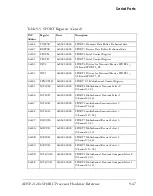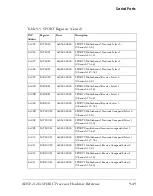
ADSP-2126x SHARC Processor Hardware Reference
9-61
Serial Ports
Overflow/Underflow status bits are set when an overflow or underflow
occurs. In multichannel mode, the
ROVF_A
or
TUVF_A
bits are redefined due
to the fixed-directional functionality of the
SPCTLx
registers. When the
SPCTL1
,
SPCTL3
and
SPCTL5
registers are configured for Multichannel
mode, the Receive Overflow bit
ROVF_A
indicates when the A channel has
received new data while the
RXS_A
buffer is full. Similarly, when the
SPCTL0
,
SPCTL2
and
SPCTL4
registers are configured for Multichannel
mode, the transmit overflow bit (
TUVF_A
) indicates that a new frame sync
signal (
SPORT0_FS/SPORT2_FS/SPORT4_FS
) was generated while the
TXSPxA
buffer was empty.
The
ROVF_A
or
TUVF_A
(bit 29) Overflow/Underflow status bit in
the
SPCTLx
register becomes fixed in Multichannel mode only as
either the
ROVF
Overflow Status bit (SPORTs 1, 3, and 5) or
TUVF_A
Underflow Status bit (SPORTs 0, 2, and 4).
When the SPORT is configured as a transmitter (
SPTRAN
=1), and a trans-
mit frame sync occurs and no new data has been loaded into the transmit
buffer, a Transmit Underflow status bit is set in the Serial Port Control
register. The
TUVF_A/ROVF_A
or
TUVF_A
status bit is sticky and is only
cleared by disabling the serial port.
When the SPORT is configured as a receiver (
SPTRAN
= 0), the receive buf-
fers are activated. The receive buffers act like a three-location FIFO
because they have two data registers plus an input shift register. Two com-
plete 32-bit words can be stored in the receive buffer while a third word is
being shifted in. The third word overwrites the second if the first word has
not been read out (by the processor core or the DMA controller). When
this happens, the Receive Overflow Status bit is set in the Serial Port Con-
trol register. Almost three complete words can be received without the
receive buffer being read before an overflow occurs. The overflow status is
generated on the last bit of the third word. The
ROVF_A/ROVF_A
or
TUVF_A
status bit is sticky and is cleared only by disabling the serial port.
An interrupt is generated when the receive buffer has been loaded with a
received word (for example, the receive buffer is not empty). This
Summary of Contents for ADSP-21261 SHARC
Page 30: ...Contents xxx ADSP 2126x SHARC Processor Hardware Reference ...
Page 40: ...Register Diagram Conventions xl ADSP 2126x SHARC Processor Hardware Reference ...
Page 58: ...Differences From Previous SHARCs 1 18 ADSP 2126x SHARC Processor Hardware Reference ...
Page 112: ...Secondary Processing Element PEy 2 54 ADSP 2126x SHARC Processor Hardware Reference ...
Page 178: ...Summary 3 66 ADSP 2126x SHARC Processor Hardware Reference ...
Page 204: ...DAG Instruction Summary 4 26 ADSP 2126x SHARC Processor Hardware Reference ...
Page 322: ...Setting Up DMA 7 32 ADSP 2126x SHARC Processor Hardware Reference ...
Page 436: ...SPORT Programming Examples 9 86 ADSP 2126x SHARC Processor Hardware Reference ...
Page 521: ...ADSP 2126x SHARC Processor Hardware Reference 11 31 Input Data Port rts IDP_ISR end ...
Page 522: ...Input Data Port Programming Example 11 32 ADSP 2126x SHARC Processor Hardware Reference ...
Page 590: ...Timer Programming Examples 14 20 ADSP 2126x SHARC Processor Hardware Reference ...
Page 796: ...I O Processor Registers A 174 ADSP 2126x SHARC Processor Hardware Reference ...
Page 800: ...B 4 ADSP 2126x SHARC Processor Core Manual ...
Page 846: ...Index I 36 ADSP 2126x SHARC Processor Hardware Reference ...















































